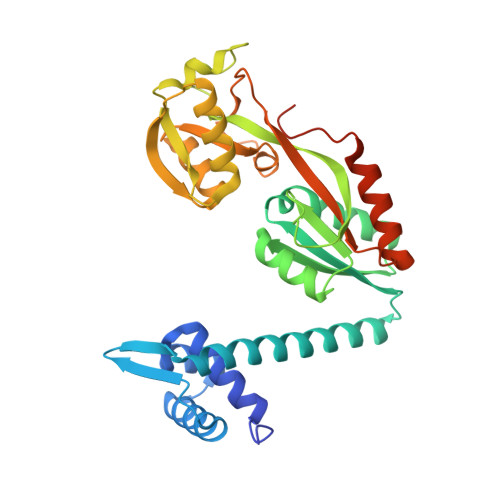Coordinating carbon and nitrogen metabolic signaling through the cyanobacterial global repressor NdhR.
Jiang, Y.L., Wang, X.P., Sun, H., Han, S.J., Li, W.F., Cui, N., Lin, G.M., Zhang, J.Y., Cheng, W., Cao, D.D., Zhang, Z.Y., Zhang, C.C., Chen, Y., Zhou, C.Z.(2018) Proc Natl Acad Sci U S A 115: 403-408
- PubMed: 29279392
- DOI: https://doi.org/10.1073/pnas.1716062115
- Primary Citation of Related Structures:
5Y2V, 5Y2W - PubMed Abstract:
The coordination of carbon and nitrogen metabolism is essential for bacteria to adapt to nutritional variations in the environment, but the underlying mechanism remains poorly understood. In autotrophic cyanobacteria, high CO 2 levels favor the carboxylase activity of ribulose 1,5 bisphosphate carboxylase/oxygenase (RuBisCO) to produce 3-phosphoglycerate, whereas low CO 2 levels promote the oxygenase activity of RuBisCO, leading to 2-phosphoglycolate (2-PG) production. Thus, the 2-PG level is reversely correlated with that of 2-oxoglutarate (2-OG), which accumulates under a high carbon/nitrogen ratio and acts as a nitrogen-starvation signal. The LysR-type transcriptional repressor NAD(P)H dehydrogenase regulator (NdhR) controls the expression of genes related to carbon metabolism. Based on genetic and biochemical studies, we report here that 2-PG is an inducer of NdhR, while 2-OG is a corepressor, as found previously. Furthermore, structural analyses indicate that binding of 2-OG at the interface between the two regulatory domains (RD) allows the NdhR tetramer to adopt a repressor conformation, whereas 2-PG binding to an intradomain cleft of each RD triggers drastic conformational changes leading to the dissociation of NdhR from its target DNA. We further confirmed the effect of 2-PG or 2-OG levels on the transcription of the NdhR regulon. Together with previous findings, we propose that NdhR can sense 2-OG from the Krebs cycle and 2-PG from photorespiration, two key metabolites that function together as indicators of intracellular carbon/nitrogen status, thus representing a fine sensor for the coordination of carbon and nitrogen metabolism in cyanobacteria.
Organizational Affiliation:
Hefei National Laboratory for Physical Sciences at the Microscale, University of Science and Technology of China, Hefei, Anhui, 230027, People's Republic of China.
















